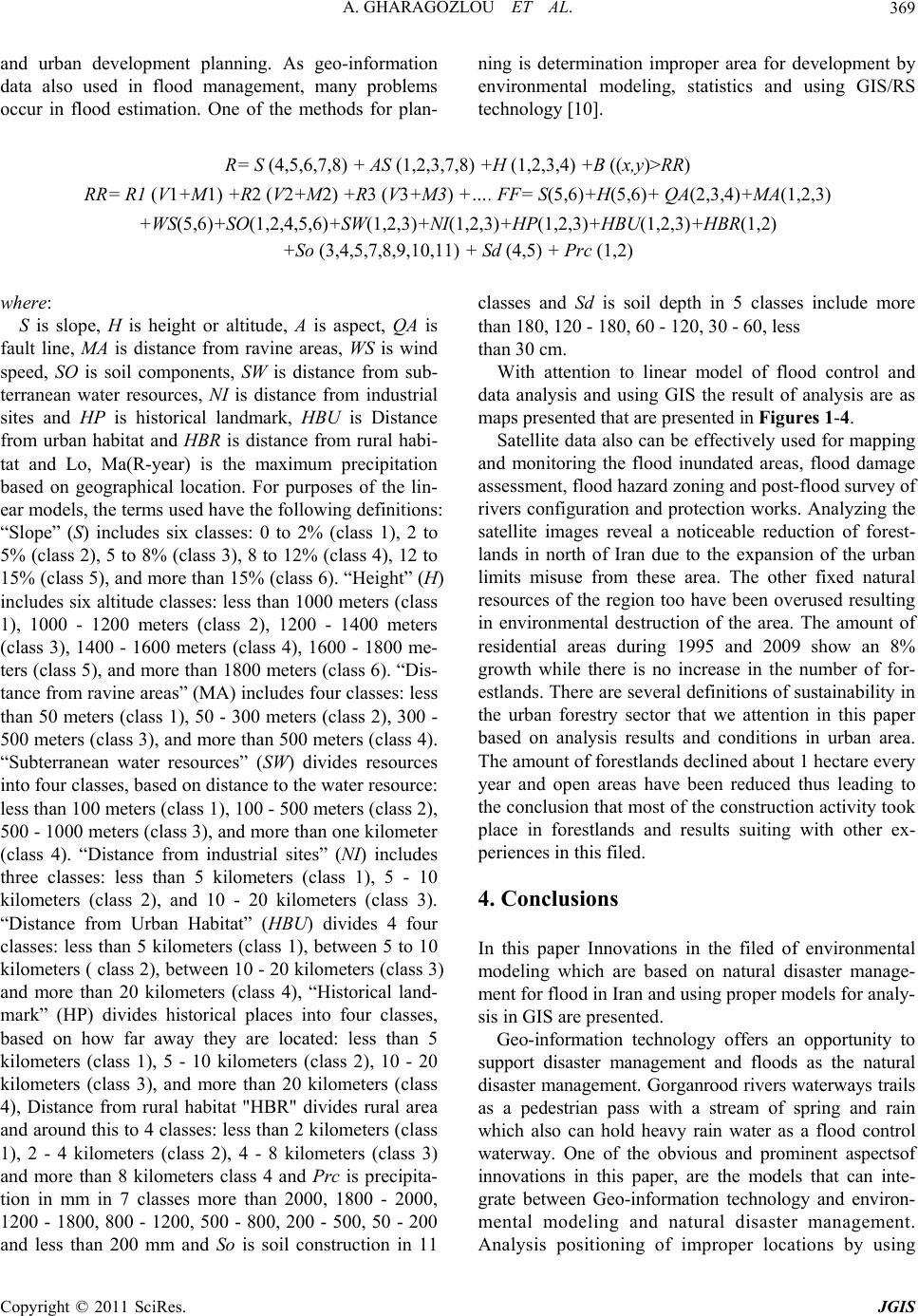
A. GHARAGOZLOU ET AL.
Copyright © 2011 SciRes. JGIS
369
and urban development planning. As geo-information
data also used in flood management, many problems
occur in flood estimation. One of the methods for plan-
ning is determination improper area for development by
environmental modeling, statistics and using GIS/RS
technology [10].
R= S (4,5,6,7,8) + AS (1,2,3,7,8) +H (1,2,3,4) +B ((x,y)>RR)
RR= R1 (V1+M1) +R2 (V2+M2) +R3 (V3+M3) +…. FF= S(5,6)+H(5,6)+ QA(2,3,4)+MA(1,2,3)
+WS(5,6)+SO(1,2,4,5,6)+SW(1,2,3)+NI(1,2,3)+HP(1,2,3)+HBU(1,2,3)+HBR(1,2)
+So (3,4,5,7,8,9,10,11) + Sd (4,5) + Prc (1,2)
where:
S is slope, H is height or altitude, A is aspect, QA is
fault line, MA is distance from ravine areas, WS is wind
speed, SO is soil components, SW is distance from sub-
terranean water resources, NI is distance from industrial
sites and HP is historical landmark, HBU is Distance
from urban habitat and HBR is distance from rural habi-
tat and Lo, Ma(R-year) is the maximum precipitation
based on geographical location. For purposes of the lin-
ear models, the terms used have the following definitions:
“Slope” (S) includes six classes: 0 to 2% (class 1), 2 to
5% (class 2), 5 to 8% (class 3), 8 to 12% (class 4), 12 to
15% (class 5), and more than 15% (class 6). “Height” (H)
includes six altitude classes: less than 1000 meters (class
1), 1000 - 1200 meters (class 2), 1200 - 1400 meters
(class 3), 1400 - 1600 meters (class 4), 1600 - 1800 me-
ters (class 5), and more than 1800 meters (class 6). “Dis-
tance from ravine areas” (MA) includes four classes: less
than 50 meters (class 1), 50 - 300 meters (class 2), 300 -
500 meters (class 3), and more than 500 meters (class 4).
“Subterranean water resources” (SW) divides resources
into four classes, based on distance to the water resource:
less than 100 meter s ( class 1) , 100 - 50 0 meters (class 2),
500 - 1000 meters (class 3), an d more th an one k ilometer
(class 4). “Distance from industrial sites” (NI) includes
three classes: less than 5 kilometers (class 1), 5 - 10
kilometers (class 2), and 10 - 20 kilometers (class 3).
“Distance from Urban Habitat” (HBU) divides 4 four
classes: less than 5 kilometers (class 1), between 5 to 10
kilometers ( class 2), between 10 - 20 kilometers (class 3)
and more than 20 kilometers (class 4), “Historical land-
mark” (HP) divides historical places into four classes,
based on how far away they are located: less than 5
kilometers (class 1), 5 - 10 kilometers (class 2), 10 - 20
kilometers (class 3), and more than 20 kilometers (class
4), Distance from rural habitat "HBR" divides rural area
and around th is to 4 classes: less than 2 kilometers (class
1), 2 - 4 kilometers (class 2), 4 - 8 kilometers (class 3)
and more than 8 kilometers class 4 and Prc is precipita-
tion in mm in 7 classes more than 2000, 1800 - 2000,
1200 - 1800, 800 - 1200, 500 - 800, 200 - 500, 50 - 200
and less than 200 mm and So is soil construction in 11
classes and Sd is soil depth in 5 classes include more
than 180, 120 - 180, 60 - 120, 30 - 60, less
than 30 cm.
With attention to linear model of flood control and
data analysis and using GIS the result of analysis are as
maps presented that are presented in Figures 1-4.
Satellite data also can be effectively u sed for mapping
and monitoring the flood inundated areas, flood damage
assessment, flood hazard zoning and post-flood survey of
rivers configuration and protection works. Analyzing the
satellite images reveal a noticeable reduction of forest-
lands in north of Iran due to the expansion of the urban
limits misuse from these area. The other fixed natural
resources of the region too have been overused resulting
in environmental destruction of the area. The amount of
residential areas during 1995 and 2009 show an 8%
growth while there is no increase in the number of for-
estlands. There are several definitio ns of sustainability in
the urban forestry sector that we attention in this paper
based on analysis results and conditions in urban area.
The amount of forestlands declined about 1 hectare every
year and open areas have been reduced thus leading to
the conclusion that most of the construction activity too k
place in forestlands and results suiting with other ex-
periences in this filed.
4. Conclusions
In this paper Innovations in the filed of environmental
modeling which are based on natural disaster manage-
ment for flood in Iran and using proper models for analy-
sis in GIS are presented.
Geo-information technology offers an opportunity to
support disaster management and floods as the natural
disaster management. Gorganrood rivers waterways trails
as a pedestrian pass with a stream of spring and rain
which also can hold heavy rain water as a flood control
waterway. One of the obvious and prominent aspectsof
innovations in this paper, are the models that can inte-
grate between Geo-information technology and environ-
mental modeling and natural disaster management.
Analysis positioning of improper locations by using